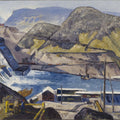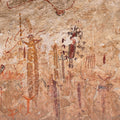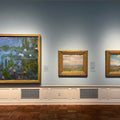San Antonio offers an introduction to artist Jesse Treviño
By Medicine Man Gallery on

Jesse Treviño, Señora Dolores Treviño (1983). Acrylic on canvas. 53.5 x 85.5 in. Collection of the San Antonio Museum of Art| Photo by Chadd Scott
“Locally famous” isn’t quite the oxymoron of “jumbo shrimp” or “organized chaos,” but when it comes to art, I always wonder what circumstances prevented “locally famous” artists from becoming just “famous” artists. I was pondering this again following a spring 2023 visit to San Antonio and introduction to “locally famous” artist Jesse Treviño (1946-2023).
Jesse Treviño’s artwork is everywhere in San Antonio.
A painting of his mother hangs prominently in the San Antonio Museum of Art around the corner from icons of American painting Wayne Thibaud and Helen Frankenthaler.
His nine-story mural Spirit of Healing produced in tile on the Children’s Hospital of San Antonio is hard to miss. Another giant mural from 2003 embellishes the plaza of the Guadalupe Center of Cultural Arts. A series of self portraits hangs in the main public library downtown.
Yet, despite writing about art across America for a living with a focus on Western art, I’d never heard of him previously. He died a couple months before my trip.
He is “locally famous.”
In most instances, three barriers separate “locally famous” artists and broad-based art world fame: race, gender and geography.
Race won’t surprise anyone. Even in the supposedly progressive, egalitarian art world, race has long held back the careers of many brilliant minority artists.
Sculptor John Scott is “locally famous” New Orleans. Painter Mike Henderson is “locally famous” in the Bay Area. The Florida Highwaymen are “locally famous” on that state’s Atlantic coast. All are Black. Three of countless examples from around the country of minority artists whose work deserves far greater celebration.
Treviño was Mexican.
Gender falls in the same category as race. America – even the arts, perhaps especially the arts – exists on a deeply rooted patriarchy.
Shirley Chisholm became America’s first Black congresswoman in 1968. She famously said, "Of my two handicaps, being female put more obstacles in my path than being Black."
Even today, female artists change their names to disguise their gender thanks to a powerful sector of collectors still preferencing the work of male artists over women.
Treviño was a man, so he didn’t have that barrier, but he did have the third: geography.
By geography, I mean distance from New York. Ever since the foundations of American art were laid in the late 18th century, New York has been the center. It remains so today.
Despite how the world has shrunken thanks to jet airplanes, the internet and cellphones, New York continues exerting a strong gravitational pull on the artworld. Ask your favorite Western artist about this, they’ll tell you. They’ve probably experienced the prejudice.
New York’s hold over the art scene in America is so strong that for every mile away from Manhattan an artist exists, her, his or their work must necessarily be that much stronger than the work being produced in New York to receive equal recognition or admiration.
Consider it grading on a reverse curve.
A “C” painting produced in New York by a New York artist and shown in a New York gallery becomes a “B” painting by association with “The City.” So too, in the other direction, does an “A” painting produced outside New York by a non-New York artist shown in a non-New York gallery.
San Antonio is a long way from New York.
Jesse Treviño: Life and Trials
Born in Monterrey, Mexico, Treviño’s family moved to San Antonio when the artist was 4-years-old. They lived on the West Side. The Hispanic side. The side removed from the touristy downtown River Walk.
His artistic talent was recognized as early as the first grade and a scholarship allowed him to live in New York attending the prestigious Arts Student League following in the footsteps of Georgia O’Keeffe, Jackson Pollock and others.
That experience was short-lived, however, as he was drafted into the Army in 1966. As a Mexican national, he didn’t have to enlist, he could have returned to Mexico without penalty. He chose to serve, as did eight of his nine brothers, for a country historically hostile to its southern neighbor – their birthplace – and its people.
A booby trap in the Mekong Delta nearly cost him his life. It would eventually cost him his right – painting – arm when complications from the injury resulted in its amputation in 1970.
He relearned how to paint using his left hand following years of agonizing physical and mental rehabilitation.
This saga recalls Michael Naranjo (Santa Clara Pueblo) who lost his eyesight due to a grenade blast while serving in Vietnam and relearned sculpting upon returning home. Or sculptor Doug Hyde (Nez Perce, Assiniboine, Chippewa) who similarly was almost killed in a grenade blast in Vietnam, but returned to the U.S., embarking on an ultimately successful art career.
Treviño’s thoughts in the immediate aftermath of the injury centered on art. He promised himself he would paint the most important aspects of his life if he survived: family, home, his friends and community.
“I’d never seen museum-quality paintings of the barrio,” he recalled.
So that’s what he produced.
Treviño, as with the other “locally famous” artists mentioned in this story, did receive a portion of national fame, not to the extent which his or their work merited, but enough to prevent them from being completely anonymous outside of their hometowns.
The Smithsonian Museum of American Art held a solo exhibition of his work in 1994. He met then-Prince Charles and Ronald Regan. He accompanied Hillary Clinton on a trip to Chile in 1998.
A biography was published in 2019. His obituary appeared in the New York Times.
Jesse Treviño is another artist who should be embraced by the Western art genre who presently is not. He was from the West, lived in the West, painted the West. Why is he not “Western?”
His background and artworks would add necessary diverse perspectives and stories of the region currently lacking.
Treviño also reinforces an important lesson Western art collectors must always remember, and that is, to trust your eye. Great art and New York are not one in the same. They can exist separate from each other. If you believe you’ve found a great painting in Tucson or Oklahoma City or Missoula or, in Treviño’s case, San Antonio. Trust yourself.
Chances are, the reason that artist is only “locally famous” has nothing to do with the work.

Jesse Treviño, Señora Dolores Treviño (1983). Acrylic on canvas. (detail) 53.5 x 85.5 in. Collection of the San Antonio Museum of Art | Photo by Chadd Scott




